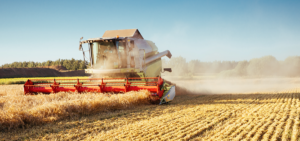Agricultural productivity is a big concept with a global impact, but it starts with efficient on-farm management. How productive or efficient our global food production systems can become will significantly impact our future well-being. A high level of productivity in the agricultural sector ensures abundant and affordable food while fostering economic growth and food security and conserving limited natural resources like land and water. This is especially critical as we face expanding populations and climate change extremes predicted to tax our current food production systems. But while agricultural productivity growth has far-reaching, planetary repercussions, improving agricultural efficiency always has and will continue to be accomplished at the farm level, using technological innovation to boost efficient farm management.
Measuring Agricultural Productivity
Getting a true sense of productivity and agricultural growth in food production at the business level is more complex than measuring yield increases or choosing the best crops suited for a specific region.
Most farms and farm businesses produce multiple products with many inputs. Oftentimes, those crop production systems support each other in a whole-farm ecosystem, such as corn planting following soybeans to break up disease cycles and lessen nutrient demands on soil health or grazing animals through harvested crops to add manure and reduce harvest residue. These sorts of operational complexities are typical in most farming businesses, whether smallholder farms or large agribusinesses, making measuring farm efficiency even more complicated.
Also, different regions and individual farms have varying degrees of obtainable agricultural productivity based on climate, soil types and other variables. Plus, farmers and cooperative farm businesses must always keep in mind the market economics of their productivity levels. A crop that grows well without significant inputs but sells for a low price because of low demand or high competition may not achieve profitability. On the other hand, if that farm can improve its efficiency metrics through new technology, it may, indeed, achieve positive economic benefits.
Tools for Measuring Productivity in the Agricultural Sector
There are multiple tools used for measuring agricultural productivity.
Total Factor Productivity (TFP)
A comparison of agricultural inputs to an index of agricultural outputs. TFP calculates the total agricultural output compared to the combination of land, labor, capital and material resources such as fertilizer, chemicals and seeds employed to generate that output.
If the total output is growing faster than the total inputs needed to produce it, then the TFP of a farm or farm business is increasing.
Yield Productivity
The maximum yield performance of a particular crop, or varietal, per hectare or unit of land area. Understanding the different crop yield productivity potential per crop or varietal is key to improving agricultural efficiency.
Technical Efficiency (TE)
Achieving technical efficiency means a farm is producing at the maximum level as allowed by the technology it has access to. Technology in this sense includes inputs like soil quality, human capital or labor availability, variable costs, capital expenses and even the age and education of the farmer can be calculated as potential factors of technical efficiency. Essentially, the measurement of TE is how efficient a farm’s management practices are based upon the inputs at its disposal.
Production Frontier
The production frontier corresponds to the farm’s maximum attainable output potential, based upon its unique set of circumstances and inputs. It’s the highest level of best management practices a specific farm could hope to achieve. For instance, rice yields in a naturally dry arid region like sub-Saharan Africa are unlikely to reach what is obtained in climates more suitable for rice production like Asia.
How to Improve Agricultural Productivity?
There are many ways farmers can improve their agricultural productivity. Strategies include:
Precision farming practices
Technology like variable-rate seeding and fertilizing allows farmers to automatically seed and apply nutrients at the exact amount needed at the precise spot to optimize the best yields for required inputs based on soil types and other data inputs.
Soil Health Practices
Optimizing natural soil fertility and water-holding capacity using soil-building practices like cover cropping to support high yields and crop quality.
High-Quality Seed Stock
Vigorous seeds, climate-specific seeds or genetically-appropriate livestock suitable for a farm’s specific conditions and requirements to help increase yields.
Mechanization and Automation.
Mechanization and automation reduce labor needs and costs while improving efficiencies.
The Four R’s
Applying the right source, at the right rate, at the right time and the right place to support good nutrient management.
Irrigation Systems
Installing a low-energy, water-efficient, and labor-friendly irrigation system supports lowered costs with better yield outcomes.
Integrated Pest Management (IPM)
Taking proactive measures to avoid, identify and treat pest and disease outbreaks when they occur.
Data Analytics
Using farm software management to collect and analyze data for the purposes of informing real-time, in-season production decisions.



